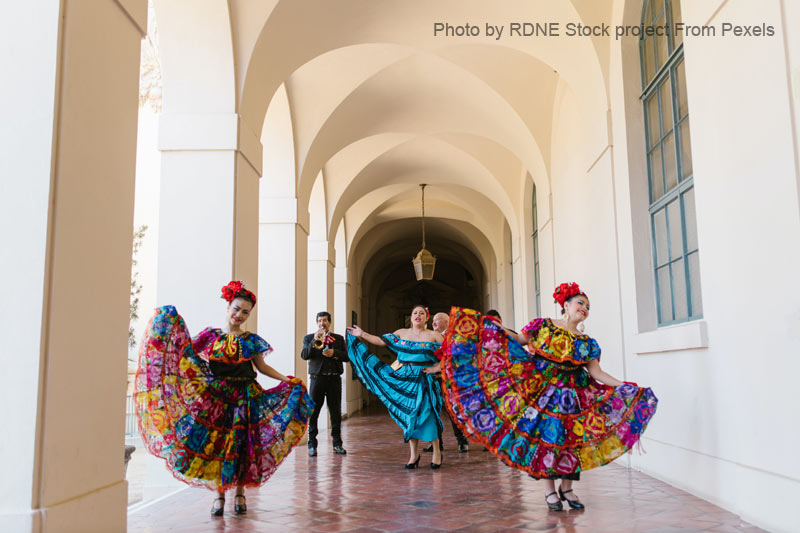Today, destination weddings remain a popular option for couples who enjoy traveling and want to incorporate that love into their special day. Mexico is a wonderful place for destination weddings, as it allows you to explore a beautiful country while enjoying special time with your spouse, family, and friends. But in addition to spending time in your destination, making memories, and exploring the area, you also can incorporate local traditions into your wedding. Learn about a few of the Mexican traditions you can incorporate into your destination wedding in Mexico.
Los Padrinos y Madrinas
A couple chooses los padrinos y madrinas, who play a significant part in the wedding. They are like godparents and often sponsor portions of the wedding, like purchasing the Bible or other elements of the ceremony. They can also give readings during the mass and host the bridal party. There are no defined roles and responsibilities for los padrinos y madrinas and no minimum or limit to how many can be included. It is an honor and privilege to be asked while also providing a way for family and friends to play a role in the ceremony.
Mariachis
Occasionally, the couple will hire mariachis to sing the hymns and religious songs performed during mass. These live musicians also can perform at various parts of the day and during the reception. Using mariachis can give your wedding a unique flair while also being a nod to the location of your destination wedding.
Church Ceremony
Catholicism is one of the primary faiths practiced throughout Mexico. If you are Catholic, you can incorporate your church ceremony in your destination wedding. Marriage is one of the seven sacraments in the Catholic faith, along with the sacraments like baptism, confirmation, and reconciliation. The church is considered the house of God and a place of worship, so Catholics consider it very important to perform this holy sacrament in the church.
When organizing your destination wedding, you should ensure a church nearby can accommodate your wedding party on your special day. Doing so will allow you to incorporate religious traditions with the other elements of your wedding theme.
Lasso Ritual
The lasso ritual is a tradition found in Mexico that involves placing a lasso, or rope, around the couple’s shoulders in a figure-eight shape to symbolize their union. This is done after the vows have been exchanged. During the ceremony, the happy couple faces each other while a long rope is placed around their shoulders, crossing or tied in the middle to form an infinity symbol (an endless loop) and represents the couple’s eternal love and unbreakable bond.
In a deeply religious ceremony, the linked rope symbolizes their unending faith and love in God as they enter into the sacred covenant of marriage. Couples from different cultures and regions have been drawn to the simple yet profound symbolism of the wedding lasso. Modern couples have also personalized this ritual with unique elements, creating many different variations and styles that are distinct from the original. That means you could use this ritual, even if you opt for a less religious ceremony.
Las Arras Matrimoniales
The arras are a set of 13 coins that are exchanged between the couple during the wedding ceremony. The coins represent Jesus and his 12 apostles, and the exchange signifies the couple’s commitment to sharing their wealth and possessions with each other. Since this does have a religious meaning, you may consider incorporating it as part of your church ceremony.
Presentation of the Bouquet
During the ceremony, the bride presents a bouquet of flowers to the Virgin Mary to symbolize her faith and to ask for her blessing. Many couples see this as another outward sign of their faith and love for God. Since Mexican weddings incorporate religious and cultural elements, you can find that they are intertwined within your special day if you get married in Mexico.
La Callejoneada and Special Dances
The parade that takes place after the wedding ceremony is known as La Callejoneada. The newlyweds lead the parade, followed by their guests and a live band. The parade usually ends at the reception venue. Once you arrive, the couple and their loved ones can engage in multiple special dances. These dances include the couple’s first dance, the father-daughter dance, the son-mother dance, and the dance of the godparents.
There is also the money dance, which is another Mexican wedding tradition that arrived from Spain. The specific origin of this dance isn’t known, but it is a way for guests to wish the couple luck in their marriage. Couples and families can get creative about collecting the money, as individuals pay a dollar to dance with the bride or groom. Sometimes, guests just throw cash on the dance floor, while others designate someone to collect the cash so the couple’s wedding attire isn’t ruined.
Once the reception is over, some couples also opt for a tornaboda, an after-party that allows the couple to continue celebrating with their guests. This is typically a smaller party. Mexican communities in the past had an open invitation to the wedding reception, so the tornaboda allows couples to celebrate with their nearest and dearest after the bigger fiesta is done. Depending on where you opt to have your destination wedding, you might end up combining your reception with your tornaboda.
Music and dancing are all an essential part of any Mexican wedding. Even if you opt for a destination wedding, you might be surprised at how many Mexican traditions you can still incorporate into your special day. While these are just a few of the traditions, at Wedding Details, we provide information about wedding traditions from around the world, helping you to do your research and find the traditions that speak to your culture and your relationship.
Wedding Details is your comprehensive guide to all aspects of your wedding. From traditional ceremonies to questions regarding the guests, our website offers you one place to do all your research.

